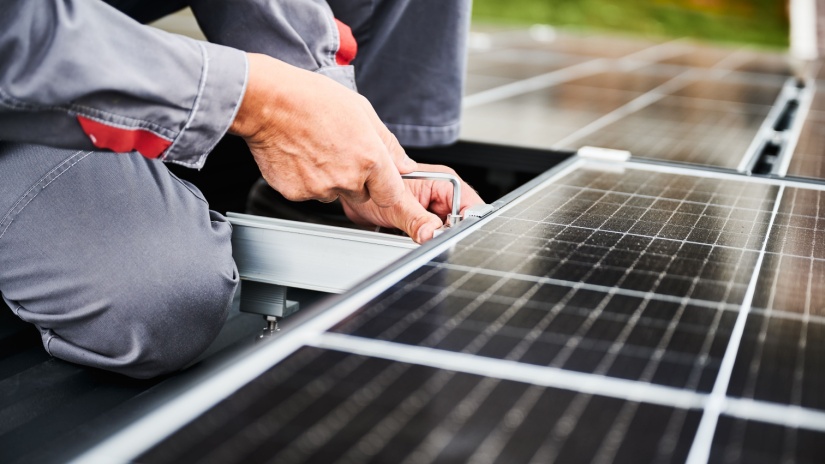Knowledge Centre
Solar panels: How often should you replace yours?
Solar panels are built to last, with a typical lifespan of 25 to 30 years. However, does this mean they won't need replacement before then? And what are the key indicators that it's time to consider installing new panels on your roof?
While many people assume that solar panels are a "set-it-and-forget-it" investment, this isn't entirely true. Solar panels require periodic maintenance, and depending on their performance, you may need to set up a solar monitoring system to track their efficiency.
Over time, factors such as wear and tear, exposure to the elements, and gradual loss of efficiency may signal that your panels are no longer operating at their peak. But how often will this happen, and what should you look out for?
Solar panel degradation
Let's begin by understanding solar panel degradation. Even the best-quality panels, installed by experts, will slowly wear down over time. This is due to constant exposure to the weather, including extreme heat, cold, wind, rain, and even bird activity.
Over time, solar panels develop small cracks in their silicon cells, known as microcracks. These microcracks grow and spread, causing the electrical connections in the panels to weaken. As a result, the panels become less efficient at turning sunlight into electricity. This gradual loss of efficiency is called "degradation" or "power degradation."
As degradation happens, the energy output of your solar panels will decrease, meaning they won’t produce as much electricity as they once did. It’s a natural process but understanding it can help you know when your panels may need replacing to keep your system running efficiently.
Does this mean I have to replace my solar panels?
Yes, eventually, you will need to replace your solar panels. While they are built to last for many years, solar panels don’t last forever. Over time, their ability to convert sunlight into electricity will gradually decline.
This is a normal part of a solar panel’s life cycle - remember, we talked about degradation. As they age, their efficiency drops, meaning they won’t generate as much electricity as they did when they were new. Factors like weather conditions, wear and tear, and general exposure to the elements contribute to this slow degradation.
Although solar panels are a long-term investment, knowing that they will need replacement down the line helps you plan for the future and ensure your energy system remains efficient.
How often should I replace them?
Solar panels are usually replaced when they get damaged or stop working as efficiently as they should. In most cases, this happens after about 25 years. However, if the panels suffer from serious defects or damage, they may need to be replaced sooner.
That being said, some solar systems can last up to 50 years, depending on weather conditions and how well they perform over time. While it’s true that solar panels lose efficiency as they get older, this doesn’t mean they stop working altogether. They just won’t produce as much energy as newer panels.
In many cases, if your panels aren’t badly damaged, the decision to replace them often comes down to personal preference. If you're happy with their current performance, you might not need to replace them right away.
Factors affecting the lifespan of your solar panels
| Factor | Description |
| Environmental | Thermal cycling: Temperature changes, especially between day and night or during weather events, cause materials to expand and contract. Over time, repeated stress can lead to joint deterioration. |
| Wind: While wind helps to keep panels cool, it can also cause them to flex, leading to potential damage over time. | |
| Humidity: In hot and humid areas such as the NT or QLD, moisture can cause corrosion and electrical issues and affect adhesive in cheaper panels. | |
| UV damage: UV radiation can degrade panels, especially if they lack UV protection. Cheaper panels may discolour and degrade faster due to poor UV resistance, which is a concern in sunny regions like Australia. | |
| Panel quality | The overall quality of solar panels affects their lifespan. When panels are higher in quality from reputable brands, they are more durable. Cheaper panels often use inferior materials and construction methods, such as badly soldered joints and weaker connections. Panels that meet Australian Standards and those from higher tier manufacturers are generally more reliable. |
| Installation | Proper installation is a must for a long panel life. A reputable installer can help with this, so look for businesses with a solid track record. |
| Maintenance | With regular maintenance come healthier panels. Routine inspections are designed to pick up on any issues such as exposed wires or loose racking before they become major issues. Regular upkeep ensures the panels last for longer. |
How to tell it’s time for a change
Here are some signs that it might be time to consider replacing your solar panels:
Reduced performance
If your solar panels are generating less energy than they used to, it could be a sign of a problem. Sometimes, a simple cleaning or part replacement can solve the issue, but other times, you may need to replace the entire panel. To determine the best course of action, it’s a good idea to consult a professional.
Physical damage
Panels can suffer from weather exposure, debris, and accidental impacts. For example, if the glass on a panel gets damaged, water might seep in and cause serious issues. Other signs of physical problems include discoloration or burn marks. Regular maintenance can help spot these issues early and prevent further damage.
Age of panels
Solar panels typically last between 25 to 30 years. As they age, their efficiency and performance usually decline. If your panels are approaching or exceeding this age range, it might be time to think about replacement.
Other system components
Sometimes, parts of your solar system like fittings or inverters might need replacement before the panels themselves do. Keeping an eye on these components ensures that your entire system remains efficient and effective.
If you notice any of these signs, it’s worth getting a professional assessment to help you decide whether to repair or replace your solar panels.
What does solar panel replacement cost?
The cost of replacing solar panels mainly depends on two factors: whether your warranty is still valid and how many panels need to be replaced. If you only need to replace one or two panels and they're still under warranty, it should be a straightforward process.
However, things can get more complex with advancements in solar technology. If the model of your panels has changed since installation—whether due to different sizes, new features, or even discontinuation—it might not be as simple as just swapping out the old panels.
Replacing individual panels can be trickier than it appears, so the best approach is to reach out to a trusted installer. They can provide you with the specific information and guidance you need to handle the replacement effectively.
What can I do to help my solar panels live longer?
Australia’s abundant sunshine makes it an ideal location for solar power, but to get the most out of your solar panels, proper maintenance is key. Here are some essential tips to help you extend the lifespan and efficiency of your panels:
Minimise shade
Shade from trees, chimneys, or nearby buildings can significantly reduce your panels' efficiency. Ensure that surrounding vegetation is regularly trimmed and clear of obstructions. This will help maximise sunlight exposure and maintain optimal performance throughout the day.
Keep panels clean
Accumulated dust and debris can impair your panels' ability to generate electricity. To maintain peak efficiency, consider having your panels professionally cleaned every few years. If you prefer to do it yourself, a gentle wash with a soft cloth and water can remove surface dirt and help keep your system running smoothly.
Choose quality panels
When selecting a solar system, prioritise high-quality panels from reputable manufacturers. Look for panels with robust warranties and those designed to endure Australia's harsh climate. Durable materials and reliable craftsmanship are crucial for long-term performance.
Schedule regular inspections
Arrange for annual inspections with a professional installer. Regular check-ups can help identify potential issues before they become serious problems. A qualified technician will ensure your system operates correctly and address minor concerns to prevent larger, costlier repairs.
Contact Compare Energy
The key takeaway is that you generally get what you pay for. While you can't control weather conditions and no panel is perfect, investing in high-quality panels and choosing a reliable installer will pay off in the long run.
Opting for cheaper panels or cutting corners with installation might save money initially, but it could cost more in the future due to reduced performance or frequent replacements. Trusting a professional installer ensures you get expert advice and the best performance from your solar system.
If you’ve become dissatisfied with your solar energy plan, why not speak to the experts at Compare Energy? We’ve got all you need to find the best solar plan for you and all you need to do is call 1300 790 106.


